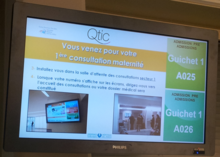Call system
Call systems or queue management systems are used to control customer traffic in authorities , retail stores or service providers . The customer receives a waiting ticket with a consecutive number from a machine or an issuing person . The numbers are managed by the call system. In the background, the numbers are assigned to the employees who are freelance for case processing or they can call up the next number. Correspondingly, the call system shows the next number in line via display boards, displays or by a call by the staff. Call systems should control the flow of visitors and customers and guarantee a fair and quick assignment of customers to clerks, salespeople or service providers.
In order to counteract peaks in the number of visitors, modern call systems also offer appointment management to distribute the flow of visitors evenly over the service times and employee capacities. The call system can then process spontaneous and appointment visitors at the same time. Access to the current waiting situation via the Internet is a useful online extension. Such an online waiting system enables access to a waiting list or appointments directly via a browser or through appropriate apps outside the waiting area.
Significance for customer satisfaction
Customer satisfaction in connection with queues is fundamentally influenced by the following factors:
- Previous experiences in queues and the subjective waiting time
- The number of other customers in the store
- Importance of time to the customer
- Distractions available
By optimizing the processes, queue management systems reduce the actual waiting time on the one hand and shorten the subjective waiting time on the other. Digital call systems can inform customers about the predicted waiting time and use psychological effects such as:
- Limited waiting time is perceived as shorter than an indefinite one.
- Subjectively, the declared waiting time is shorter than the unexplained waiting time.
- Fulfilled time seems shorter than unfulfilled time. A waiting time known in advance can be used for other things.
- Subjectively, just waiting times are shorter than unjust waiting times.
Distribution of call systems
While in many countries, especially in Scandinavia , call systems can also be found in retail (sausage counters, bakers, etc.), in Germany they were primarily used in authorities with a large number of public traffic. The more complex systems are now also used in retail, financial service providers, public transport and healthcare. Often, in order to filter out simple queries, people are assigned to issue the numbers. These are known as floor or welcome managers. Alternatively, terminals are set up that offer a selection on touchscreen monitors.
In Brazil , in other countries in South America and some countries in Eastern Europe, you can find call systems not only at authorities, but also at banks .
Individual evidence
- ↑ Claudia Raupold: Consumer behavior and queue management: Understanding the psychological influencing factors in queues better and influencing them in a targeted manner , pp. 26–30. Edited by Diplomica Verlag, Hamburg, 2009, ISBN 978-3-8366-2712-2 .
- ↑ Investigation of the benefits of digital queuing and welcome management for customer satisfaction. Retrieved on May 17, 2018 (German).
- ↑ Claudia Raupold: Consumer behavior and queue management: Understanding the psychological influencing factors in queues better and influencing them in a targeted manner , pp. 33–44. Edited by Diplomica Verlag, Hamburg, 2009, ISBN 978-3-8366-2712-2 .
- ↑ Everyday life in Sweden: Please pull the number. Retrieved on May 14, 2010 (German).
- ↑ Call system at the cash registers in the textile trade ( Memento from March 15, 2014 in the Internet Archive )
- ^ Zeit Online (2009) - Bahn wants to shorten waiting times



